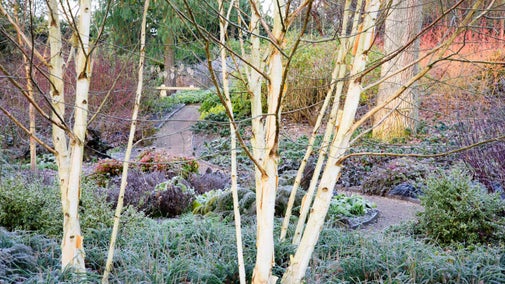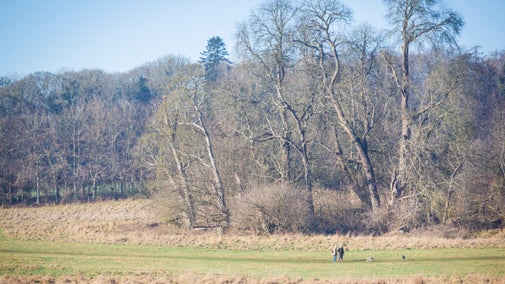
Discover more at Mottisfont
Find out when Mottisfont is open, how to get here, the things to see and do and more.

The walled garden at Mottisfont is home to the National Collection of Pre-1900 Shrub Roses, which creates an annual spectacle in early summer. Unlike modern species, these historic roses tend to flower just once a year, so their blooming is an extraordinary annual sight. Traditionally June is the peak of flowering, but nowadays the annual festival of colour and scent is likely to be at its height earlier in May. Once the roses have gone over we will begin deadheading from July onwards. However, we leave many of the spent blooms to form ornamental hips, which provide colour and food for birds in autumn.
Over 1,000 individual rose plants bloom in our walled garden during peak season. Climbers are trained onto red-brick walls, and shrub roses are set in beds among other flowers with complementary colours and foliage to show them off at their best.
Many of the roses we care for only flower once a year.
While it’s tempting to tidy a rose by cutting off the blooms once they've passed their best, we leave the once-flowering shrubs and ramblers to produce rosehips. As well as providing a colourful display in winter, the rosehips are also an essential food source for wildlife.
We deadhead any repeat-flowering shrubs by pruning directly after flowering. This encourages the rose to bloom again later in the summer, and often into the autumn.
We then prune all our roses over winter, starting in early December and working right through until March.
We extend our garden opening hours in early summer on Thursdays, Fridays and Saturdays to give people more opportunities to visit the roses. Look out for more information on our website and social media in due course.
You’re welcome to pack a picnic too, to enjoy in our paddocks.
Flowering just once a year, in late May to mid-June, the blooming season of this magnificent collection of roses attracts thousands of visitors. Here's some information to help you plan your visit at one of our busiest times of the year:

The first walled garden is our recently revived Kitchen Garden, where two beds of 11 types of rose provide a modern introduction to the hundreds you’ll find beyond.
Walkway arbours are decorated with four varieties of climbing rose, based on Graham Stuart Thomas’ choice of companion roses. Hedging of Rosa rugosa ‘Rubra’ leads you into these arbours, mirroring the entrance to the central garden.
In the central garden, you’ll find deep, box-lined borders full of rambling and climbing roses and clematis trained on the high brick wall behind. The main paths crossing the site converge on a central round pond and fountain, surrounded by eight clipped Irish yews.
Either side of this historic central pathway are two deep herbaceous flower beds filled with many of Graham Stuart Thomas’ favourite perennials, chosen for their structure, scent and wide colour palette.
Agapanthus, geraniums and peonies mingle with pinks, lilies, phlox and nepeta. The centres of the borders are a mass of soft blues, pinks and whites, whilst stronger yellows, oranges and dark pinks draw your eye along the length of the border.
Long borders brim with plants chosen to complement and underplant the roses. They also extend the season, providing colour, shape and scent before the roses bloom and after their petals fall. In June the roses are accompanied by striking spires of white foxgloves.
The northern section of the walled garden, with its wide paths, is deliberately planted with a 'cool' colour palette to provide a counterpoint to the central Rose Garden.

More than 20 volunteers have signed up as Rose Garden Volunteers, and will be on hand throughout rose season to answer your questions or seek advice on your behalf from our rose specialists. The volunteers, who will be working in twos on a daily basis, will be easily identifiable in their navy blue polo shirts sporting a pink rose badge.
Created by Graham Stuart Thomas – one of the most important figures in 20th-century British horticulture – in the 1970s, Mottisfont’s walled garden was chosen to house many varieties that may otherwise have become extinct.
- Graham Stuart Thomas, An English Rose Garden (1991)
With an artist's eye and consummate knowledge, Graham Stuart Thomas designed a garden that would combine roses with a mix of perennials to give a season-long display.
Pop into the café to try Jude's rose-flavoured ice cream, as well as a range of other delicious flavours.
We know that not all of you will be able to visit during the rose season, so please enjoy this video tour that we made with Emma McNamara, the Horticultural Development Specialist for the National Trust.
Join Emma McNamara, the Horticultural Development Specialist for the National Trust to explore the Rose Garden at Mottisfont
We ask for your permission before anything is loaded, as this content may introduce additional cookies. You may want to read the Google YouTube terms of service and privacy policy before accepting.

Find out when Mottisfont is open, how to get here, the things to see and do and more.
Enjoy every season at Mottisfont, with its ancient trees and babbling brooks, from rich autumn foliage and the scented Winter Garden to snowdrops, the first harbingers of spring and, of course, the world-famous Rose Garden.

We make compost in vast quantities at Mottisfont, keeping the soil healthy and ensuring the garden, including the famous rose collection, is looking its very best.

Explore Mottisfont’s diverse estate, criss-crossed by the crystal-clear River Test, and south Hampshire countryside sites of Stockbridge Down and Marsh and Curbridge Nature Reserve.

Explore Maud Russell’s 1930s neo-classical interiors, in an 18th-century house with medieval origins and enjoy changing art exhibitions in the spacious gallery.

Discover Mottisfont’s eight centuries of history and transformation. From medieval priory to the 18th-century structure, housing Maud Russell’s stylish 20th-century redevelopment.

Mottisfont offers a fantastic family day out, with something for everyone. As well as the wild play area, scenic river and meadow, there are specially-designed activities for pre-schoolers and exciting events every school holiday. Enjoy perfect winter picnic spots, delicious treats from our cafés, and convenient baby-changing facilities - all in a beautiful, welcoming environment.
